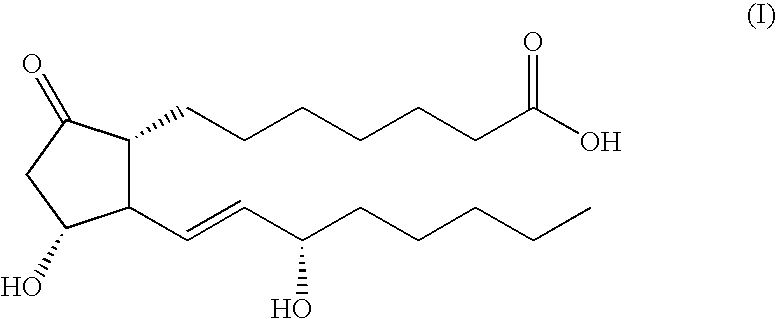Emulsion composition comprising prostaglandin e1
a technology of prostaglandin and emulsion composition, which is applied in the field of emulsion composition, can solve the problems that dipalmitoyl phosphatidylcholine (dppc) with a higher purity, which cannot provide such improvement, and achieve the effect of improving the stability of pge1
- Summary
- Abstract
- Description
- Claims
- Application Information
AI Technical Summary
Benefits of technology
Problems solved by technology
Method used
Image
Examples
example 1
Preparation of an Emulsion Composition TLC01 Comprising PGE1 and Polysorbate 80
[0035]An emulsion composition comprising PGE1 of formula (I) and a non-proton-providing surfactant, polysorbate 80, was prepared in this Example. Methods similar to that of this Example may be used to prepare an emulsion composition comprising any other PGE1, and any other non-proton-providing surfactant.
[0036]The PGE1 of formula (I) and other chemicals were purchased from Sigma, USA. Polysorbate 80 was purchased from Sigma, USA, NOF corp., Japan, or Imperial Chemical Industries PLC, London, United Kingdom. The MCT oil (a mixture of triglycerides mainly containing not less than about 95% of caprylic acid and capric acid), such as LIPOID MCT® purchased from Lipoid GmbH, Germany or Panacet 810® from NOF Corp., Japan. Egg phosphatidylcholine (EPC) (purity: 95˜100% and purity: 80˜85%) were purchased from Avanti, USA, NOF Corp., Japan, or Lipoid GmbH, Germany.
[0037]A composition containing 0.9 g of EPC (purity...
example 2
Preparation of Emulsion Compositions Comprising PGE1 and Other Non-Proton-Providing Surfactants
[0038]Using methods similar to that described in Example 1, different emulsion compositions comprising PGE1 and different non-proton-providing surfactants were prepared.
[0039]Non-proton-providing surfactants were obtained from various sources. Polyethylene glycol-15-hydroxystearate (Solutol® HS15) and polyoxyl 35 castor oil (Cremophor® EL) were obtained from BASF, Germany. D-alpha-tocopheryl polyethylene glycol 1000 succinate (TPGS) was obtained from Eastman, USA. 3-(N,N-dimethylpalmitylammonio)propanesulfonate and dodecyltrimethylammonium bromide were obtained from Sigma, USA. DSPE-mPEG2000 was purchased from Avanti, USA, or NOF Corp., Japan.
[0040]The components and their amounts in various emulsion compositions are listed in Table I.
TABLE IComponents and Their Amounts of the Emulsion CompositionsOil BaseEmulsifierAuxiliary emulsifierPGE1GlycerolWaterFormula(g)(g)(g)(mg)(g)(g)Liple ®101.8...
example 3
Determination of Shelf Stability of PGE1 in the Emulsion Compositions
[0041]Shelf stability of PGE1 in an array of emulsion compositions was determined in this example. Methods similar to that of this Example may be used to determine shelf stability of any PGE1 in any emulsion composition comprising PGE1.
[0042]A commercially available product Liple® (Mitsubishi Pharma Corp., Tokyo, Japan) was used as a reference in comparison with the emulsion compositions according to embodiments of the invention. The components and their amounts in various emulsion compositions for comparison are listed in Table I.
[0043]The stability of PGE1 in the emulsion compositions, which were stored in sealed clear ampoules and in the dark, was determined in terms of the percentages of PGE1 retained after the incubation of the emulsion compositions at 40° C. for one week or one month by HPLC analysis. The stability of PGE1 in the emulsion compositions was also determined by the appearance (phase separation or...
PUM
| Property | Measurement | Unit |
|---|---|---|
| molecular weight | aaaaa | aaaaa |
| average molecular weight | aaaaa | aaaaa |
| average molecular weight | aaaaa | aaaaa |
Abstract
Description
Claims
Application Information
 Login to View More
Login to View More - R&D
- Intellectual Property
- Life Sciences
- Materials
- Tech Scout
- Unparalleled Data Quality
- Higher Quality Content
- 60% Fewer Hallucinations
Browse by: Latest US Patents, China's latest patents, Technical Efficacy Thesaurus, Application Domain, Technology Topic, Popular Technical Reports.
© 2025 PatSnap. All rights reserved.Legal|Privacy policy|Modern Slavery Act Transparency Statement|Sitemap|About US| Contact US: help@patsnap.com

